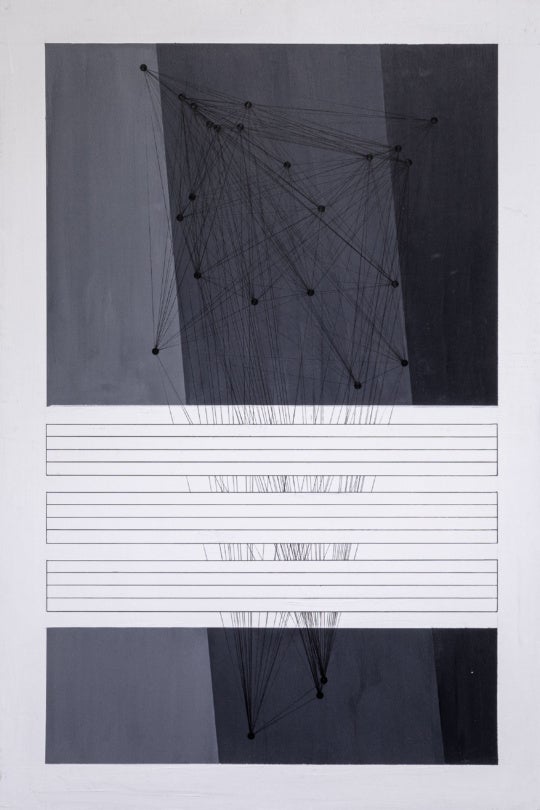
“Sam Wang: Total Immersion,” recently on view at the Light Factory in Charlotte, comprised more than two dozen black-and-white photographs made between 2010 and 2015, all shot and displayed in a circular format that mimics the shape of a camera lens. The spherical scenes, printed on crisp white backgrounds, vary in size, the largest being nearly three feet in diameter. To produce his signature round pictures, Wang builds cameras—several of which were on display—that allow him to capture the entire image field through a wide-angle lens. (Typical commercial cameras have shutters and sensors that crop each frame into a rectangle.) Other examples of his innovations to the platinum/cyanotype alternative process were on display as well.
Deep River Gorge, Spain typifies the sense of comfortable vastness Wang achieves. Though the view is sweeping, the circular format provides a concentration of mass in the foreground that sets up an immediate visual connection. It then deftly draws viewers into the middle ground, inviting them to explore and journey farther into the lush expanse.
Long established in the field of photography, Wang has spent the past five decades as a fine artist, teacher, and innovator. Born in Beijing, he grew up in Hong Kong, and eventually moved to the United States to attend college. After graduating from the University of Iowa with an MFA in photography, Wang joined the faculty of Clemson University in South Carolina, where he established the school’s photography program. He spent the next 40 years growing that program, and in 2006, retired as the Alumni Distinguished Professor of Art. Wang’s works are in the collections of the Metropolitan Museum of Art and the High Museum of Art, and other notable institutions. Furthermore in 2010, the monograph Sam Wang—Four Decades of Photographic Explorations was published by China Jiangsu Arts Publishing.

“Total Immersion” featured local images shot in North and South Carolina, as well as those taken abroad, in China and Spain. Much of Wang’s subject matter is rooted in the traditional: nature, landscapes, and the human figure. However, the absolute border of the circle, along with dramatic depth of field and light play, give the compositions a dynamic, at times surreal, edge.
Timeless in subject yet modern in composition, ZP Venus celebrates the classical beauty of the female figure. The alabaster nude stands in a graceful yet commanding contrapposto, in bold proximity to the lens with her arms stretched overhead. A distinctive radiance surrounds her, as the nondescript, shadowy landscape recedes into the soft background. Wang composed this piece using a customized pinhole camera—a basic device known for light leaks and diminished focus. The resulting image presents a striking juxtaposition of light and dark, along with slight spatial distortion.
Suggestive of such universal themes as infinity and life cycles, Wang’s circles create a microcosm that is at once encapsulated and free. The Earth-shaped forms define the space, producing a telescopic effect that intensifies the continuous movement between foreground and background. Of his work, Wang writes, “it’s much less about round shapes than about total immersion in observation.” To that end, his photographs offer a visual fecundity, manifested in tightly cropped compositions filled with abundant foliage, iconic natural forms, and graceful characters that are both human and manmade. The various elements remain in constant conversation with each other. Shimmering swaths of kudzu crawl up telephone poles or envelop cars, as if a welcome rebirth within the dilapidated constructs of human civilization. A nude figure stretches across a tree, physically and visually immersed in her surroundings, in effect harnessing that most fundamental essence of nature.

Pylons with Skirts, China continues the conversation as Wang pairs natural and manmade elements that reflect the ambiguities of our culture. Despite their detached, solitary placement, the manufactured monoliths seem to be part of the natural landscape as they rise up from the earth like the distant trees. The silky tones and deep, engaging perspective create an aura of calm amid the discord, even as the windblown fabric atop the pylon offers a reminder of imminent change. Perhaps they signify human progress, or conversely, its failure.
Ultimately, Wang’s circular photographs open up the visual field to invite viewers to look more deeply. They encourage us to experience the wealth of visual information, and even excitement, that comes from engaging each image with more than a cursory glance.
“Total Immersion” was on view at the Light Factory, Charlotte NC, from May 26 through July 1.
Elizabeth L. Delaney is a freelance arts writer and publications editor. She has written for Art Papers, Art Lies, and Southwest Art magazines, and regularly pens press releases, catalogue essays, and other materials for galleries, artists, and nonprofit arts organizations. Before embarking on a freelance career, she worked as the curator of education at a contemporary art museum, and then as the director of publications for an international performing arts organization.




